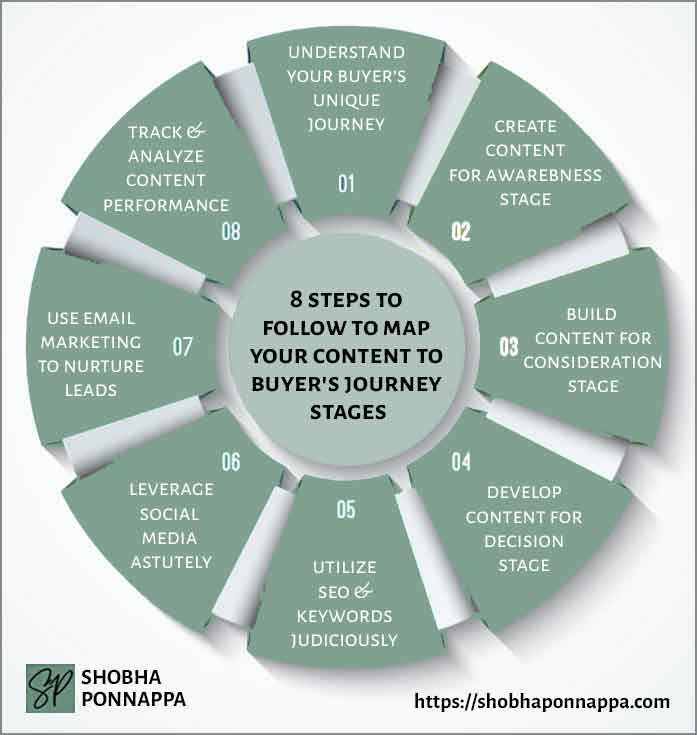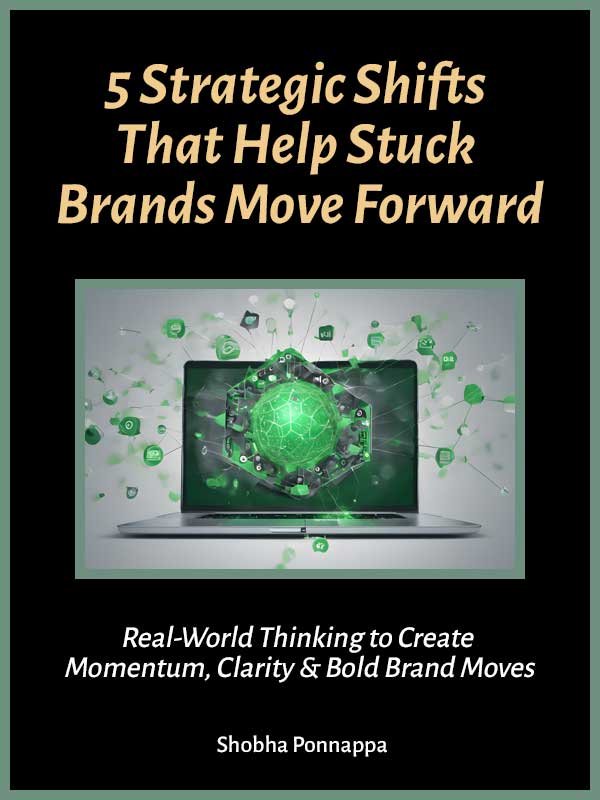
Businesses today face the challenge of attracting attention and also guiding potential customers effectively through their buying process. The key lies in strategically mapping content to align with each stage of the buyer’s journey.
This approach increases engagement while also driving conversions.
However, achieving this requires a delicate balance of conventional wisdom and innovative tactics.
By blending tried-and-true methods with creative, out-of-the-box strategies, companies can create a unique and compelling content journey that resonates deeply with their audience, setting themselves apart in a crowded market.
The buyer’s journey is a fundamental framework in marketing, describing the process a potential customer goes through before making a purchase.
It typically comprises three key stages: Awareness, where the customer identifies a need or problem; Consideration, where they research and evaluate different solutions; and Decision, where they finally choose a product or service. Mapping content to each of these stages is crucial for businesses seeking to effectively guide and influence their customers’ decisions.
Tailored content for each stage ensures that potential buyers receive the right information at the right time, aiding their progression through the journey. This strategic alignment not only enhances user experience but also boosts the chances of conversion.
By understanding and catering to the specific needs and behaviors at each stage, businesses can build trust, establish authority, and ultimately drive successful sales, turning prospects into loyal customers.
Mapping content to the buyer’s journey effectively demands a blend of proven methods and innovative, unconventional approaches – a principle central to my “Unusual By Strategy” forte.
Traditional tactics, like using SEO-optimized blog posts for the Awareness stage or detailed case studies for Consideration, provide a solid foundation. However, the addition of unusual ideas can dramatically enhance engagement and impact.
For instance, interactive content such as quizzes in the Awareness stage or virtual reality experiences in the Consideration stage can offer immersive experiences that conventional methods can’t match. In the Decision stage, personalized video messages or AI-driven content recommendations can make a memorable impression.
This dual approach not only caters to diverse audience preferences but also sets a brand apart in a competitive digital landscape. Emphasizing this blend in content strategy ensures that while reliable methods build trust, innovative techniques captivate and convert, aligning perfectly with my commitment to deliver content that is as distinctive as it is effective.
Leveraging my 40+ years’ experience as a Brand Content Strategist with a penchant for the unusual, I have curated eight ideas that blend time-tested approaches with creative twists for mapping content to every stage of the buyer’s journey.
These strategies are designed to not only align with the conventional wisdom of content marketing but also to infuse unique elements that set them apart. The goal is to ensure that each stage of the journey, from Awareness to Decision, is not just covered effectively but also enhanced with innovative techniques that captivate, engage, and convert audiences in today’s competitive digital landscape.

Effective content marketing hinges on a deep understanding of your buyer’s unique journey, recognizing that each potential customer’s path to purchase is distinct.
For instance, a tech company might find that its buyers initially seek information through educational blog posts during the Awareness stage, use comparative infographics in the Consideration stage, and look for detailed user reviews before making a final decision. This insight allows for the creation of tailored content that resonates with the audience at each specific phase.
By mapping out the journey and identifying key touchpoints, content can be strategically designed to guide and influence the buyer’s decision-making process. Such a targeted approach not only increases the relevance and effectiveness of the content but also enhances the overall user experience, leading to higher engagement and conversion rates.
Understanding the nuances of your buyer’s journey is not just about observing trends but actively anticipating needs and preferences, thereby creating a more personalized and impactful content marketing strategy.

Consider the idea of “Journey Personalization Through AI.” This unusual enhancement involves leveraging artificial intelligence to plan the dynamic adjustment of content based on real-time user interactions and behaviors. For the tech company example, as a visitor navigates through the site, AI algorithms could be programmed to analyze their interactions – what they click, how long they stay on pages, and what they search for.
This data then automates and tailors the content they see next. If a user spends time on introductory tech blogs, the AI might suggest more detailed articles on specific technologies, subtly guiding them from Awareness to Consideration. This personalized journey not only makes the content more relevant and engaging for each individual but also streamlines their path towards decision-making, making the entire process more efficient and effective.
Crafting content for the Awareness Stage is pivotal in introducing potential customers to a brand or solution and addressing the initial realization of a need or problem.
For instance, a health and wellness company might produce engaging blog posts, infographics, and social media content that highlight common health concerns or wellness tips. These pieces are not designed to sell products directly but to inform and educate the audience, fostering trust and brand recognition.
The content should be easily digestible, relatable, and shareable, focusing on general topics that resonate with a broad audience. This approach helps to establish the brand as a credible source of information, encouraging potential customers to return for more insights.
Effectively, content at this stage lays the groundwork for a relationship with the audience, setting the stage for more targeted marketing efforts in the subsequent stages of the buyer’s journey.

Consider the idea of “Interactive Storytelling Experiences.” This unusual enhancement involves creating immersive, interactive content that allows the audience to actively participate in the narrative. For the health and wellness company, this could mean developing an interactive journey where users make choices about their daily health routines, leading to different outcomes and insights.
As users engage with the story, they not only learn about health and wellness but also see the impact of different choices in a dynamic, personalized way. This approach makes the Awareness Stage content more engaging and memorable, encouraging deeper interaction with the brand and laying a stronger foundation for moving potential customers to the next stage of their journey.
Building content for the Consideration Stage is about offering deeper, more detailed information that helps potential customers evaluate and compare different solutions to their problems.
Let’s suppose a home gardening company is targeting customers who have moved past the Awareness Stage and are now considering specific gardening solutions. At this point, the company could provide comprehensive guides on different types of gardening methods, comparison videos between various gardening tools, and detailed blog posts about the benefits of home gardening.
This content should be rich in detail and tailored to answer more specific questions, helping customers weigh their options. It’s about demonstrating expertise and providing value that guides the buyer closer to a decision.
The content should position the company’s products or services as the ideal solution, subtly nudging the customer towards the next stage, which is making a decision, all while providing genuine, useful information that reinforces the brand’s authority in its field.

Consider the idea of “Virtual Reality Demonstrations.” This unusual enhancement involves using virtual reality (VR) technology to create immersive demonstrations of products or services. For the home gardening company, this could mean developing a VR experience where customers can virtually step into different garden layouts, interact with various gardening tools, and see the potential results of using their products.
Such an immersive approach provides a hands-on feel and a deeper understanding of the products, far beyond what traditional content can offer. This VR experience not only engages customers in a novel way but also gives them a realistic preview, helping them to make a more informed decision in the Consideration Stage of their buyer’s journey.
Developing content for the Decision Stage is critical in swaying potential customers towards finalizing their purchase. At this juncture, buyers are seeking reassurance and validation of their choice.
For example, a boutique hotel chain, aiming to convince potential guests at this stage, could create content showcasing detailed room tours, customer testimonials, and exclusive offers. These should highlight unique experiences and amenities that set the hotel apart.
The content needs to be compelling and persuasive, often incorporating elements like special promotions, guarantees, or limited-time offers to create a sense of urgency. It’s also crucial to provide clear and accessible calls-to-action, guiding the customer smoothly through the booking process.
This stage’s content should aim to alleviate any last-minute hesitations, reinforcing the value proposition and customer benefits, to effectively convert consideration into bookings.

Consider the idea of “Personalized Decision Portals.” This unusual enhancement involves creating a bespoke online space for each potential customer, tailored to their specific interests and interactions with your brand. For the boutique hotel chain, this could mean developing a personalized webpage for each potential guest who has shown interest, featuring a custom video greeting, a curated list of rooms and amenities based on their browsing history, and exclusive offers.
This portal not only provides all the necessary information for making a decision but also adds a personal touch, making the potential guest feel valued and understood. Such a customized approach in the Decision Stage can significantly increase the likelihood of conversion, offering a unique and memorable experience that sets the brand apart.
Utilizing SEO and keywords judiciously is a crucial aspect of aligning content with the buyer’s journey. This approach ensures that the content not only resonates with the target audience but is also easily discoverable.
For example, a company specializing in eco-friendly office supplies can use specific keywords like ‘sustainable office products’ or ‘green office solutions’ in their content. These keywords should be strategically placed in blog titles, meta descriptions, and throughout the content to improve search engine rankings.
This targeted SEO strategy helps in attracting potential customers who are searching for eco-friendly options, particularly in the Awareness and Consideration stages. Moreover, by regularly updating content with relevant keywords based on current trends and search patterns, the company can maintain its visibility and relevance.
Effective use of SEO and keywords bridges the gap between the company’s content and the audience’s search queries, enhancing the overall effectiveness of the content marketing strategy throughout the buyer’s journey.

Consider the idea of “Semantic Evolution in SEO.” This unusual enhancement involves going beyond traditional keyword optimization and incorporating semantic search principles into your content strategy. For the eco-friendly office supplies company, this means not just using specific keywords like ‘sustainable office products’ but also creating content that contextually relates to broader topics in sustainability and eco-conscious living.
By doing so, the content aligns with the way modern search engines interpret user intent and related topics. This approach helps in capturing a wider audience who might not use exact keywords but are interested in the overarching theme of sustainability. Such a nuanced application of SEO makes the content more discoverable and relevant to a diverse set of search queries, enhancing visibility across various stages of the buyer’s journey.
Leveraging social media with astuteness involves strategically using various platforms to engage with your audience at different stages of the buyer’s journey.
For instance, a boutique travel agency might use Instagram to capture the interest of potential travelers in the Awareness Stage with stunning visuals of destinations. As these prospects move to the Consideration Stage, the agency could use Facebook to post detailed travel itineraries and reviews from past travelers.
Finally, in the Decision Stage, targeted offers and last-minute deals could be promoted through Twitter, directly encouraging bookings. Each platform serves a specific purpose, aligning with the distinct needs and behaviors of customers at each journey stage.
This approach ensures that the content not only reaches the audience but also resonates with them, driving engagement and, ultimately, conversions. Smart social media use, therefore, becomes a powerful tool in a comprehensive content marketing strategy, effectively guiding potential customers through their journey.

Consider the idea of “Geo-Targeted Storytelling.” This unusual enhancement involves using geolocation data on social media platforms to deliver customized content narratives based on the audience’s location. For the boutique travel agency, this means creating stories and posts on platforms like Instagram or Facebook that are tailored to the audience in specific regions.
For example, viewers in colder climates might see content featuring warm, tropical destinations, while those in urban areas are shown serene countryside retreats. This targeted approach ensures that the content is not only relevant but also resonates on a personal level, significantly increasing engagement and the effectiveness of the content in guiding potential customers through the buyer’s journey.
Using email marketing to nurture leads is a strategic way to maintain engagement and gently guide potential customers through the buyer’s journey. Imagine a specialty coffee brand that captures email addresses through a ‘Guide to Brewing the Perfect Cup’ on its website.
This brand can then send a series of targeted emails, each designed for different stages of the buyer’s journey. Initially, emails might focus on educating subscribers about different coffee origins and brewing methods, catering to the Awareness Stage.
As the customer progresses, emails can shift to comparisons of coffee varieties and equipment, aiding those in the Consideration Stage. Finally, for those nearing the Decision Stage, the brand could send special offers, customer testimonials, or even invitations to exclusive coffee-tasting events.
This method keeps the brand top-of-mind, provides value at each stage, and builds a relationship that encourages conversion from a lead to a loyal customer.

Consider the idea of “Interactive Email Journeys.” This unusual enhancement involves integrating interactive elements into email campaigns to create a more engaging and personalized experience. For the specialty coffee brand, this could mean embedding interactive features like flavor preference quizzes, aroma selection sliders, or even a virtual coffee-tasting session within their emails.
As subscribers interact with these elements, the email content adapts and evolves based on their choices and interactions, providing a tailored experience that resonates with their specific interests and stage in the buyer’s journey. This dynamic approach not only captivates the audience but also provides deeper insights into their preferences, enabling the brand to further refine their nurturing strategy and strengthen the connection with their leads.
Tracking and analyzing content performance is essential to understand how effectively your content is guiding potential customers through the buyer’s journey.
Consider a company specializing in eco-friendly home products. By using analytics tools, the company can track which blog posts, infographics, or videos are most effective at attracting viewers in the Awareness Stage. In the Consideration Stage, the company can analyze which comparison guides or detailed product descriptions lead to longer page visits or more engagement.
Finally, for the Decision Stage, the company can measure conversion rates from specific promotional content or targeted calls-to-action. This data not only helps in identifying which types of content work best at each stage but also provides insights into areas for improvement.
Regularly analyzing content performance allows for data-driven decisions, ensuring that the content strategy remains aligned with audience needs and behaviors, ultimately leading to better engagement and higher conversion rates.

Consider the idea of “Predictive Content Analytics.” This unusual enhancement involves using advanced analytics tools that not only track current content performance but also predict future trends and audience behaviors. For the eco-friendly home products company, implementing predictive analytics could mean analyzing vast amounts of data from various sources to forecast which types of content will resonate best with their audience in the future.
This could involve predicting emerging eco-friendly trends that their audience might be interested in or identifying which types of content formats will likely gain popularity. By incorporating predictive analytics into their strategy, the company can stay ahead of the curve, creating content that not only meets current audience needs but also anticipates future interests and behaviors, ensuring continued relevance and engagement throughout the buyer’s journey.
Strategic content mapping: Effectively mapping content to each stage of the buyer’s journey – Awareness, Consideration, and Decision – is crucial. Tailoring content to meet the specific needs and questions of the audience at each stage ensures a seamless transition and enhances engagement and conversion rates.
Innovative techniques and analytics: Blending traditional content marketing strategies with innovative techniques and predictive analytics offers a competitive edge. This approach includes using unusual methods like interactive storytelling or AI-driven personalization to captivate the audience, alongside tracking and analyzing content performance for continuous improvement.
Holistic multi-channel approach: Utilizing a mix of channels – from SEO and social media to email marketing – and understanding their unique role in different journey stages is essential. Each channel should be leveraged judiciously to create a cohesive and comprehensive content marketing strategy that effectively guides potential customers through their buying journey.

"As a Content/Brand Specialist, and SEO/UX Writer, I can help transform your brand's online presence. I can lift it with innovative ideas to take it to an enviable position. Let's collaborate to create a captivating brand story, engage your audience, boost your online visibility, and increase your ROI. Take the next step towards your brand content success and contact me today."
Shobha Ponnappa
I Bring You:
Content Marketing That’s “Unusual By Strategy” … Tips, Tricks, Tactics, Techniques, Trends, Training.
Get my weekly ContenTracker Newsletter packed with loads of content marketing ideas – proven and unusual.
Get a free download of my ebook on “50 Unusual Ways To Use AI In Content Marketing” … and transform your success.

Just fill in the form to join my community … we have big and small brands for company. You’ll stay on the speedway to growth.
KEY TOPIC CATEGORIES COVERED ON THIS SITE:
COPYRIGHT © 2025. SHOBHAPONNAPPA.COM. ALL RIGHTS RESERVED.

Just fill in this form and get this awesome guide via email. Plus … each fortnight you’ll receive my Brand Reframe Newsletter that brings you smart insights, distilled thinking, and focused brand momentum.